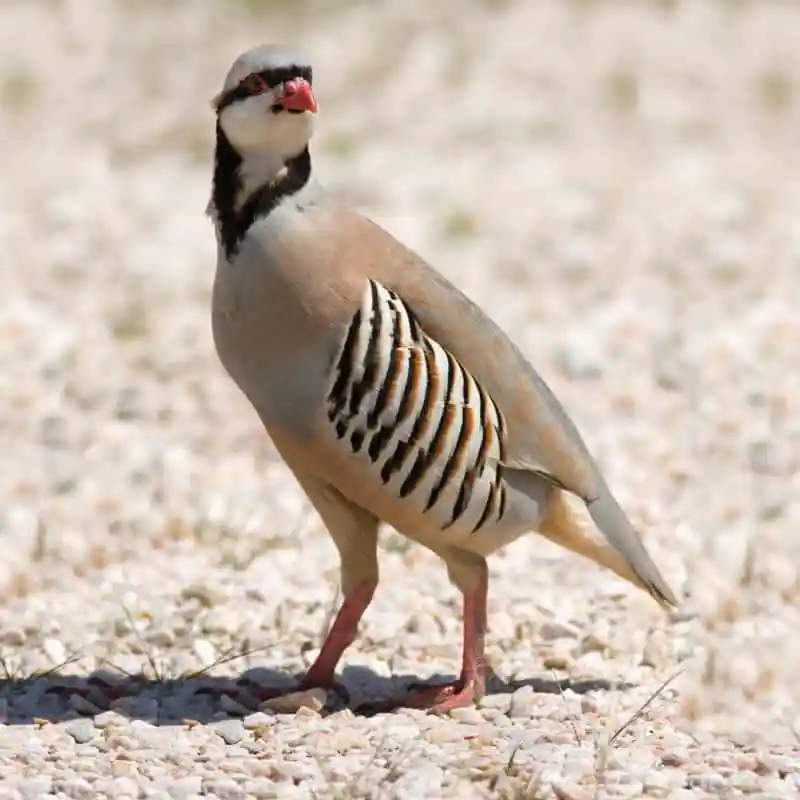In the rich cultural tapestry of North India and Pakistan, traditions and symbolism often intertwine with nature and wildlife. Among the many fascinating creatures that hold symbolic significance, the Chukar Partridge stands out for its association with love, passion, and a touch of mystery.
This article explores the cultural and natural aspects of the Chukar Partridge, shedding light on its role in these regions and its potential as Pakistan’s national bird symbol.
Cultural Significance of the Chukar Partridge
Chukar Partridge in North Indian and Pakistani Tradition
In both North Indian and Pakistani cultures, the Chukar Partridge ( چوکور ) carries symbolic weight, particularly in matters of the heart. References to the Chukar Partridge and its symbolic significance can be found in ancient texts and folklore.
The bird is often associated with ardent love, emphasizing the intensity of emotions and the passionate nature of affection.

The Symbolism of Love and Passion
The National Bird of Pakistan Chukar Partridge’s connection to love is rooted in its behavior. According to folklore, this bird is believed to be deeply infatuated with the moon, spending its days gazing at its luminous presence. This unrequited love symbolizes the intensity and sometimes one-sided nature of human affections, capturing the imagination of poets and romantics alike.
Chukar Partridge in Pakistan
Fighting Birds and Breeding Season
Beyond its cultural significance, the National Bird of Pakistan Chukar Partridge plays a unique role in the breeding season. In certain areas, these birds are maintained for their ferocious behavior, as they exhibit aggressive tendencies during this period. While such practices are controversial and even illegal, they reflect the awe-inspiring nature of these birds and the fascination they evoke.
Controversial Hunting Practices
Pakistan and Afghanistan witness the peak of Chukar Partridge hunting during the months of June and July. Hunters, eager to experience the thrill of the chase, venture into the wilderness armed with permits and licenses. However, it is essential to address the need for responsible hunting practices and the preservation of these remarkable creatures.
Pakistan’s Diverse Bird Population
Pakistan boasts a remarkable avian diversity, owing to its diverse climate and varied terrain. The country serves as a haven for numerous rare and exceptional bird species, attracting millions of migrating birds from all corners of the globe. Wetlands, lakes, dense forests, and mountains provide ideal habitats for both native and migrant birds, inviting birdwatchers from around the world to marvel at their beauty.
Unique Birds in Pakistan
The diverse landscape of Pakistan accommodates an array of unique birds. From the majestic Himalayan Monal to the graceful White-throated Kingfisher, the country is a treasure trove for bird enthusiasts. The wetlands and lakes, in particular, serve as vital stopover points for migratory birds, offering a glimpse into the wonders of nature.
Birdwatching Opportunities
To cater to the growing interest in birdwatching, the Pakistani government has established numerous conservation areas. These protected zones not only allow native and migratory birds to thrive but also provide opportunities for birdwatchers to observe them in their natural habitat. The ethereal dance of a Black-necked Crane or the melodious call of a Yellow-bellied Fantail can leave visitors enchanted.
Government Conservation Efforts
Recognizing the importance of preserving Pakistan’s avian heritage, the government has taken steps to safeguard these species. Conservation areas and initiatives aim to create a conducive environment for birds to flourish, ensuring their continued presence for generations to come. By striking a balance between conservation and responsible tourism, Pakistan endeavors to protect its feathered treasures.
Description of the Chukar Partridge
Physical Characteristics
The National Bird of Pakistan Chukar Partridge is a captivating bird with distinct physical features. It possesses a round-shaped body, measuring approximately 34-38 cm in length. Its back displays a light brown color, while the breasts exhibit a grayish hue. The bird’s stomach appears buff, and its face is adorned with a white coloration, accentuated by a black gorget. Stripes of rufous adorn its flanks, and its legs stand out with a bright red hue.

Historical Range and Distribution
The National Bird of Pakistan Chukar Partridge belongs to the pheasant species and is native to Eurasian grasslands. Its historical range extends from Pakistan and Kashmir to southeastern Europe. Over time, this remarkable bird has also been introduced to other parts of the world, such as Canada, the United States, Hawaii, and New Zealand. In some regions, hybrids between the Chukar Partridge and the Red-legged Partridge, brought from elsewhere, have become relatively common.
Chukar Partridge as Pakistan’s National Bird
Arguments for Designation
Given its cultural significance and unique attributes, the Chukar Partridge presents a strong case for being designated as Pakistan’s national bird symbol. The bird’s representation of passionate love resonates with the country’s cultural values, while its diverse presence across various regions symbolizes unity in diversity. By embracing the Chukar Partridge as a national symbol, Pakistan can celebrate its rich natural and cultural heritage.
Conservation and National Pride
Designating the Chukar Partridge as Pakistan’s national bird can serve as a catalyst for conservation efforts. Such recognition would raise awareness about the importance of protecting the bird’s habitats and fostering a sense of pride and responsibility among the population. Preserving the Chukar Partridge and its ecosystem would not only benefit the species itself but also contribute to the overall conservation of Pakistan’s natural treasures.
Chukar Partridge’s Behavior and Habitat
Social Behavior
Chukar Partridges exhibit fascinating social behavior. They prefer to dwell in communities known as coveys, which consist of 5 to 40 members. These birds exhibit a broad diet, encompassing a range of grains and insects. Their communal nature allows them to forage together, strengthening their social bonds.
Nesting and Reproduction
During the breeding season, Chukar Partridges construct nests in sparsely lined dirt scrapes. The female lays an impressive number of eggs, ranging from 8 to 20, usually incubating them for 22 to 24 days. Interestingly, some females may lay two distinct clutches of eggs, with the male attending to one clutch while the female nurtures the other. This unique reproductive behavior further adds to the bird’s allure.
Flight and Evasive Tactics
When faced with danger, Chukar Partridges prefer running to flying. Their rounded wings allow them to take short flights when necessary. Hunters often find it challenging to track and hunt these birds due to their swift upward flight and their ability to disappear swiftly into the dense undergrowth.
Chukar Partridge’s Role in Culture

Symbolism in Indian Culture
In North Indian and Pakistani traditions, including Hindu culture, the Chukar Partridge holds symbolic significance. It is often associated with passionate, and at times unrequited, love. According to folklore, the bird is infatuated with the moon, spending its days gazing upon it. Such cultural associations have embedded the Chukar Partridge deeply within the fabric of society.
Ferocity in Breeding Season
In certain regions, Chukar Partridges are kept and maintained as fighting birds during the breeding season. Their ferocious behavior during this period adds an element of excitement to this practice. Although such activities may be considered illegal by officials, the phenomenon highlights the fascination and intrigue surrounding these remarkable creatures.
Conservation Efforts and Conclusion
The Chukar Partridge’s presence in Pakistan is a testament to the country’s rich biodiversity and natural heritage. Conservation efforts by the government and various stakeholders have contributed to the preservation of this species and its habitats. By raising awareness, promoting responsible hunting practices, and designating the Chukar Partridge as Pakistan’s national bird, the country can embrace its avian wonders while ensuring its long-term survival.
In conclusion, the Chukar Partridge stands as a symbol of love, resilience, and unity in Pakistan’s natural landscape. It’s captivating attributes and cultural significance make it a deserving candidate for national recognition. By valuing and protecting these remarkable birds, Pakistan can cherish its avian heritage for generations to come.
FAQs
- Is hunting Chukar Partridges legal in Pakistan? Hunting Chukar Partridges is only permitted with a valid hunting permit or license during the designated hunting season.
- Why is the Chukar Partridge significant in Indian culture? In Indian culture, the Chukar Partridge symbolizes passionate and sometimes unrequited love, infatuated with the moon.
- What are some unique birds found in Pakistan? Pakistan is home to a diverse range of unique bird species, including the Himalayan Monal and the White-throated Kingfisher.
- Do Chukar Partridges migrate? Chukar Partridges are resident birds, meaning they do not undertake long-distance migrations.
- What are the conservation efforts for Chukar Partridges in Pakistan? The government of Pakistan has established conservation areas and initiatives to protect the habitats and promote the conservation of Chukar Partridges and other bird species.


